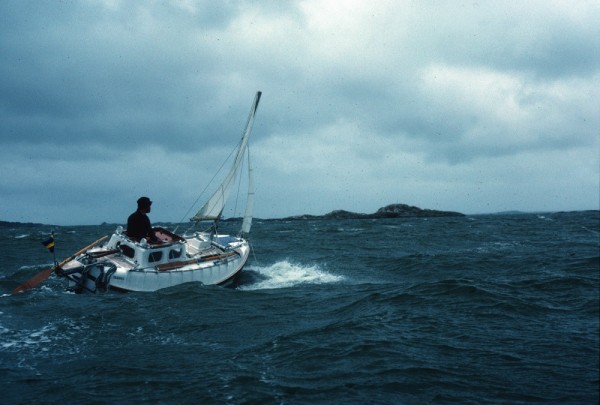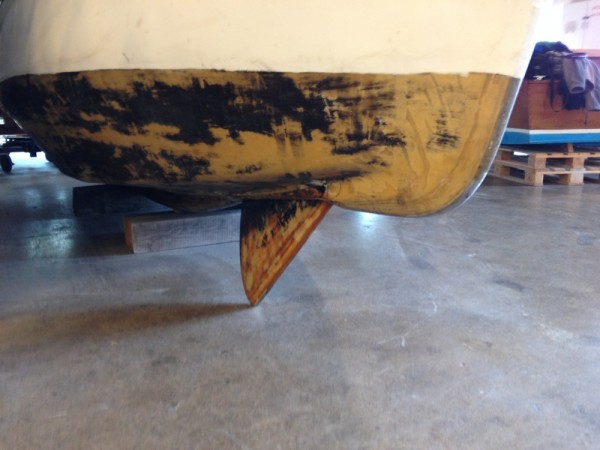To my disappointment the presentation of Yrvind Tens slotted leeboards was not universally met with rapturous applause. Some people think they will cause too much drag and not be strong enough. Therefore I valiantly feel obliged to come to their defense.
Aviators did invent the name but not the flaps, navigators did. The classical rudder attached to a long keel is a flap. If the tiller is moved a few degrees to weather the boat becomes more weatherly. That the rudder in that position creates a bit more drag is a minor point as long as the boat wins races. On the other hand, going to the extreme by moving the sail area forward so that you can keep the tiller 10 or 15 degrees to weather will increase the keels lifting force even more but then the drag will be so great that the boat has no chance of winning.
If the boat is propelled by sail and not an airplane engine the flap can and must of course be designed accordingly. I also like to point out that the leeboard is overlapping the flap. Therefore it will be attached not on the foils weak trailing edge but more forward in a position, strong enough.
From a fluid dynamic point of view the constellation mainsail and overlapping genua is a slotted flap as A. Gentry has shown. Land yachts use slotted wings and they are very fast. To my mind if slotted flaps can be used on sailing boats for rudders and sails I see no reason why I should not use them on my leeboards, its just a question of good engineering.
Why do I not use a long fixed keel as is suggested? Well it is certainly quite OK for heading into gales, but in my opinion, a centerboard or leeboard placed well forward the sail area is a much better option, and like I have said before, when retracted less likely to capsize the boat. It gives you a choice.
1989 I sailed the 15 feet Bris-Amfibie from Ireland to Newfoundland against the prevailing westerly’s. The mast was ten feet long. In heavy weather I had a 1 square meter jib and a 2 square meter triangular main. Between 6 and 18 of June we had continues contrary gales. The boat had a centerboard. It was placed well forward of the mast. Its area was about ¼ of a square meter (0.6 m deep x 0.4 m cord). Finally after 12 days the sun came out and I got a chance to fix my position. To my joy it was more westerly then when the gales had started.
We arrived in St Johns after 47 days. It had been a stormy passage but no capsizes, nothing broken, all the plastic jerry cans topped up with rainwater.
Before leaving Sweden I gave some yachtsmen lessons in celest navigation. They where bound for Nova Scotia.
“We might see each other on the other side” I suggested.
“I am not so sure” their captain said.
“Your boat is so much smaller it will take you longer time and we cannot wait for you.”
It was an argument plausible enough. After all they had a modern powerful 35 feet boat equipped with a strong diesel engine, big fuel tanks, radar and all the other stuff. I had my oar and sextant.
In the end we never meet them. The North Atlantic had been too stormy that year, they later told me. After two weeks they had turned around and run. Everything was a mess in their boat. Later they sold her.
The problem with a long fixed keel like the one Manie B is planning to have on his ten footer is that going downwind he will get weather helm and a lot of drag. On a circumnavigation there will hopefully be much downwind sailing. Leeboards on the other hand, they have even less drag than centerboards because the smooth bottom will cause no turbulence. In strong following winds I will use my twin rudders like a snowplow giving her a lot of inherent course stability.
All my experience and all my knowledge speak against the long fixed keel. Please do not use it. I never go back to it.
Below are some pictures of Bris Amphibie. The centerboard can be lowered further had not the floor been there. Click once or twice to enlarge.
Above Bris Amphibie sailing her main is 2 meter square her jib 1 meter square.
The boat.
A bit of the centerboard can be seen.
Regards Yrvind.



